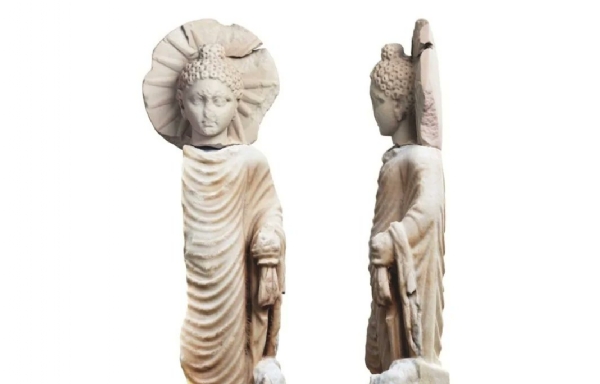Buddha statue of 2nd century discovered in Egypt reveals historical links with India
Total Views |
A statue depicting Buddha that dates from the 2nd century AD from the Roman era has been unearthed in Egypt, providing an intriguing glimpse into the ancient ties between India and Egypt. It has been discovered in Egypt’s ancient Red Sea town of Berenice, giving information on the Roman Empire’s trading relations with India, reported AFP.

A statement by the antiquities ministry said that a Polish-US delegation discovered the figure "dating back to the Roman era while digging at the ancient temple in Berenice." The head of Egypt’s supreme antiquities council Mostafa al-Waziri said that the finding has important indications over the presence of trade ties between Egypt and India during the Roman era.
The statue, with part of its right side and its right leg missing, measures 71 centimetres (28 inches) in height and portrays Buddha with a halo around his head and a lotus flower by his side, reported AFP. Waziri said Berenice was one of the largest seaports in Roman-era Egypt, and was often the destination for ships from India laden with spices, semi-precious stones, textiles and ivory.
History
According to a Twitter handle called @Paracelsus1092, Buddha statue discovered must be around of 2nd century AD Egyptian city. The temple at Berenike also showed Sanskrit inscriptions and coins from the Satavahanas.
Berenike, also known as Berenice Troglodytica was an Ancient Egyptian seaport on the western shore of the Red Sea, Egypt. The city was founded by Ptolemy II Philadelphus (285- 246 BC), who named it after his mother, Berenice I of Egypt.
During the Roman period, between the 1st and 2nd century AD, the city was one of the primary waystations for the trade of war elephants and exotic goods such as pepper, semi-precious stones, cloth, and ivory, transported between India, Sri Lanka, Arabia, and Upper Egypt.
Buddha statue discovered in 2nd century AD Egyptian city. The temple at Berenike also showed Sanskrit inscriptions and coins from the Satavahanas. pic.twitter.com/AFtoiYxGKg
— Stone Age Herbalist (@Paracelsus1092) April 28, 2023
According to Dr. Marius Goyazda, the stone used for the statue may have originated from a region south of Istanbul, with one theory suggesting that traders from India had the statue carved locally and dedicated to the nearby temple. Excavations of the temple also discovered an inscription in Hindi (Sanskrit), dating from the reign of the Roman Emperor, Philip the Arab (AD 244 to 249), in addition to Greek inscriptions which are from the 1st century BC.
Archaeologists also uncovered two coins from the central Indian kingdom of Satavahana, an ancient Indian dynasty based in the Deccan region. The Satavahanas were one of the first Indian kingdoms to produce state coinage struck with images of their rulers, with the two coins found at Berenice Troglodytica dated to around the 2nd century AD.
Egypt has unveiled many major archaeological discoveries in recent years, amid attempts to revive its vital tourism industry after years of political unrest and the COVID-19 pandemic. By 2028, the Egyptian government hopes to attract 30 million tourists per year, up from 13 million before the pandemic.

